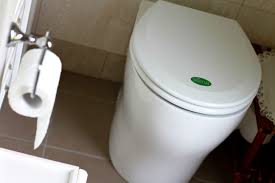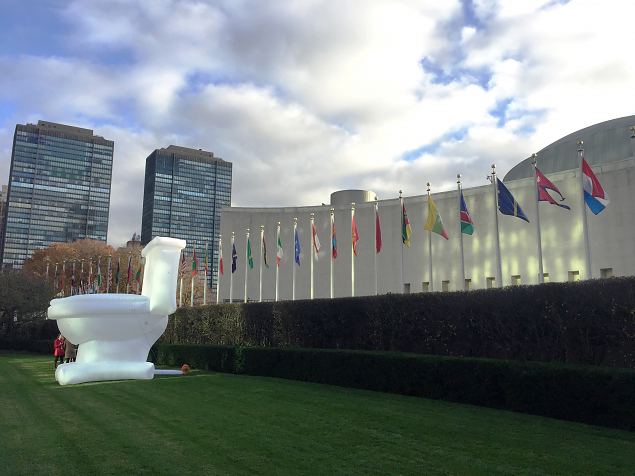 Dry toilet – the Coming up with an off-grid wastewater treatment solution can be challenging; especially if living in rural areas where no particular option is supported. There are many possibilities from various treatment facilities to septic and sewage tanks. However, one option that is often overlooked is a dry toilet. Mia O’Neill The author lives in the Finnish countryside in a relatively modern house with two evaporating dry toilets, a compost and a greenhouse Dry toilet – the pipeless option
Dry toilet – the Coming up with an off-grid wastewater treatment solution can be challenging; especially if living in rural areas where no particular option is supported. There are many possibilities from various treatment facilities to septic and sewage tanks. However, one option that is often overlooked is a dry toilet. Mia O’Neill The author lives in the Finnish countryside in a relatively modern house with two evaporating dry toilets, a compost and a greenhouse Dry toilet – the pipeless option Cleaner water
in your village and aroundDry toilet – the pipeless option
Coming up with an off-grid wastewater treatment solution can be challenging; especially if living in rural areas where no particular option is supported. There are many possibilities from various treatment facilities to septic and sewage tanks. However, one option that is often overlooked is a dry toilet.
Dry toilet as a concept brings to mind a smelly outhouse with flies and unpleasant odours. Fortunately, the modern dry toilet is nothing of the sort! There are numerous models for different types of houses, from seasonal use to everyday use, with or without electricity, and so on. In this blog post, some most common “pipeless” solutions will be covered.
The basic functioning principle of a dry toilet is the fact that liquids are separated from the solids, either from source or later. It is the mixture of urine and excreta that creates the foul odour of a toilet compost, and that is what a properly designed dry toilet tries to avoid.
Another important feature is functioning air conditioning: the exhaust vent should be installed from the compost (=toilet waste) chamber straight outside the building without any extra angles, and all other exhaust vents should be blocked. This way, the only way the air is removed from the toilet room is through the toilet itself, and all odours go out that way too.
When liquids and ventilate are separated in your toilet, there has been already ensured the proper functioning of your dry toilet. | ||
Types of dry toilet But what type of toilet should be chosen? As said, there are several options that all have their pros and cons, just like any wastewater treatment system.
The most basic type of dry toilet is a dry toilet that collects all the toilet waste and the liquid is allowed to trickle out at the bottom of the compost. This type of dry toilet is easy to even do-it-yourself, and adding a few holes and a bucket under your smelly outhouse will turn it into an upgraded version. An inside version with a large container for the toilet waste has a great capacity and does not need to be emptied often.
A more sophisticated version is a urine diverting dry toilet, which diverts urine from the source, i.e. the seat, to a separate container. This keeps the compost dry and allows the safe reuse of urine as fertiliser. Urine is an excellent source of nitrogen and has been proven to be a safe and efficient fertiliser for a variety of food crops.
Urine should be stored in an air tight container for 6 months for it to become sterile before using as fertiliser. When spreading it, mix urine with water (e.g. 1:3 dilution) to avoid any odour issues. Urine separation is a great way to utilise the potential of urine especially if you have the opportunity to store and use urine on your own property. Bear in mind one human produces approximately 500 litres of urine per year.
If urine storage or reuse is not possible on your property, there are still other dry toilet options you might want to consider. Different models evaporate the liquid or even incinerate the toilet waste into ash. These models use more energy but they reduce the amount of toilet waste into a drier form. There are also models that freeze the toilet waste.
It is important to remember that even dry toilet waste, let alone frozen waste (if using the freezing toilet model), must still be composted thoroughly before using it as soil. |
Benefits A dry toilet solution, no matter which type you choose, is a significantly cheaper option than any other wastewater treatment system. It is also cheap to run, using only a small amount of energy and making it possible for you to empty and compost the toilet waste yourself. A simple toilet solution can cost only a few hundred euros, while the more complex models, such as evaporating and incinerating ones, can cost from 2000 euros to up to 5000 euros. Still, the price is small compared to larger wastewater systems.
One should not forget the ecological aspects of dry toilets. By composting toilet waste and, when possible, collecting the urine for fertiliser use we are supporting the natural closed nutrient cycle rather than mixing the nutrients with water for no good reason. Returning the nutrients we have consumed back to soil, in fact the soil’s condition are improved and on the other hand prevent eutrophication by stopping the nutrients getting into lakes and rivers. Put simply, the nutrients end up in the right place where they do good.
Especially for those who have their own gardens or greenhouses, fertiliser use of urine is also beneficial. It is a source of free, organic and efficient fertiliser that is good for most food crops, fruit trees, berries, vegetables and flowers. |
What about greywater? When toilet waste is taken care of by dry toilet, the only wastewater produced by a household is greywater, e.g. water used in cooking, cleaning and washing. To properly treat greywater, it is possible to construct a simple soil treatment system, where the greywater is filtered through layers of soil. However, even this system may not be required if attention is paid to the quality of household wastewater. By using phosphate free washing detergents, avoiding putting any food waste down the drain and favouring organic cleaning products, it is possible to minimise the nutrient load of greywater. Yet, even with a soil filtering system in place, the pipeless option is a more economical way to implement a wastewater treatment system. |
Think outside of the box! Dry toilet is no longer considered an old-fashioned or poor option. The technology is developing and more and more options for a variety of needs are created constantly. Also the basic dry toilet models suit modern households who are environmentally conscious. When planning a wastewater treatment system, it is definitely recommended to at least consider the dry toilet option.
For more information, see for instance www.huussi.net/en.
Mia O’Neill The author lives in the Finnish countryside in a relatively modern house with two evaporating dry toilets, a compost and a greenhouse. |
|
VillageWaters Project
VillageWaters suggest most effective wastewater treatment solutions in scattered dwellings households, which use their own, independently operated water purification systems.
Helping Homeowners
Environmentally oriented families and homeowners, who live in scattered dwellings areas, where connecting to larger wastewater plants is not option because rural distances.
Project publications
Information Tool, article base and blog will be linked directly to our website.
See also our Facebook pages

Communication
SYKLI Environmental School of Finland
PL 72, 11101 Riihimäki, Finland
Jari Heiskanen (Chief Web Manager),
phone. +358 50 375 2657,

